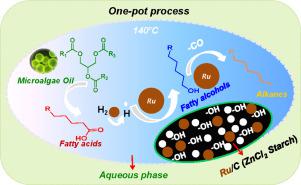当前位置:
X-MOL 学术
›
Chin. J. Catal.
›
论文详情
Our official English website, www.x-mol.net, welcomes your feedback! (Note: you will need to create a separate account there.)
Ru nanoparticles supported on hydrophilic mesoporous carbon catalyzed low-temperature hydrodeoxygenation of microalgae oil to alkanes at aqueous-phase
Chinese Journal of Catalysis ( IF 16.5 ) Pub Date : 2020-08-01 , DOI: 10.1016/s1872-2067(20)63539-2 Arif Ali , Chen Zhao
Chinese Journal of Catalysis ( IF 16.5 ) Pub Date : 2020-08-01 , DOI: 10.1016/s1872-2067(20)63539-2 Arif Ali , Chen Zhao

|
Abstract The processing of an energy carrier such as microalgae oil into valuable fuels and chemicals is quite promising. Aqueous-phase processing is suitable for this purpose because the separation of intrinsic water from the algae cell is difficult. In this study, we synthesized ruthenium (Ru) nanoparticles supported on highly hydrophilic mesoporous carbon to catalyze the quantitative hydrodeoxygenation (HDO) of microalgae oil to alkanes in a one-pot process at a low temperature (140 °C) in the aqueous phase. The mesoporous carbon was obtained by single-step calcination of starch and zinc chloride in nitrogen. The as-obtained carbon showed high surface areas and pore volumes, allowing high dispersion of Ru nanoparticles. The surface of the carbon material was rich in hydroxyl groups, as evidenced by X-ray photoelectron spectroscopy (XPS), infrared (IR) spectroscopy, and thermogravimetric analysis (TGA) measurements. As a result, the carbon material contacted preferably with the water phase versus the organic phase, improving the accessibility of substrates. On the other hand, the contact angle test results speculated the superior hydrophilic nature of mesoporous Ru/C (ZnCl2, starch) than commercial Ru/C. Both kinetics modeling and in situ IR monitoring in water revealed the superior performance of the hydrophilic mesoporous and hydrophilic Ru/C compared to a commercial Ru/C for the tandem hydrogenation of stearic acid and decarbonylation of stearyl alcohol. The herein designed hydrothermal carbon material was highly active, environmentally benign, sustainable, and recyclable material, and could be potentially used for other hydrogenation reactions in the aqueous phase.
中文翻译:

载于亲水性介孔碳上的 Ru 纳米粒子催化微藻油在水相中低温加氢脱氧为烷烃
摘要 将微藻油等能量载体加工成有价值的燃料和化学品很有前景。水相处理适用于此目的,因为从藻类细胞中分离固有水是困难的。在这项研究中,我们合成了负载在高亲水性介孔碳上的钌 (Ru) 纳米粒子,以在水相中在低温 (140 °C) 的一锅法中催化微藻油定量加氢脱氧 (HDO) 为烷烃。通过在氮气中一步煅烧淀粉和氯化锌获得介孔碳。所获得的碳显示出高表面积和孔体积,允许 Ru 纳米粒子的高度分散。X射线光电子能谱(XPS)证明,碳材料表面富含羟基,红外 (IR) 光谱和热重分析 (TGA) 测量。结果,与有机相相比,碳材料优选与水相接触,从而提高了基材的可及性。另一方面,接触角测试结果推测介孔 Ru/C(ZnCl2、淀粉)的亲水性优于商业 Ru/C。动力学建模和水中的原位红外监测都表明,与商业 Ru/C 相比,亲水介孔和亲水 Ru/C 在硬脂酸的串联氢化和硬脂醇的脱羰方面具有优异的性能。本文设计的水热碳材料是一种高活性、环境友好、可持续和可回收的材料,有可能用于水相中的其他加氢反应。
更新日期:2020-08-01
中文翻译:

载于亲水性介孔碳上的 Ru 纳米粒子催化微藻油在水相中低温加氢脱氧为烷烃
摘要 将微藻油等能量载体加工成有价值的燃料和化学品很有前景。水相处理适用于此目的,因为从藻类细胞中分离固有水是困难的。在这项研究中,我们合成了负载在高亲水性介孔碳上的钌 (Ru) 纳米粒子,以在水相中在低温 (140 °C) 的一锅法中催化微藻油定量加氢脱氧 (HDO) 为烷烃。通过在氮气中一步煅烧淀粉和氯化锌获得介孔碳。所获得的碳显示出高表面积和孔体积,允许 Ru 纳米粒子的高度分散。X射线光电子能谱(XPS)证明,碳材料表面富含羟基,红外 (IR) 光谱和热重分析 (TGA) 测量。结果,与有机相相比,碳材料优选与水相接触,从而提高了基材的可及性。另一方面,接触角测试结果推测介孔 Ru/C(ZnCl2、淀粉)的亲水性优于商业 Ru/C。动力学建模和水中的原位红外监测都表明,与商业 Ru/C 相比,亲水介孔和亲水 Ru/C 在硬脂酸的串联氢化和硬脂醇的脱羰方面具有优异的性能。本文设计的水热碳材料是一种高活性、环境友好、可持续和可回收的材料,有可能用于水相中的其他加氢反应。



























 京公网安备 11010802027423号
京公网安备 11010802027423号